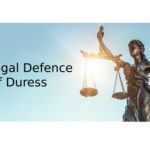The Legal Defence of Necessity In New South Wales

Four seamen are stranded on a life raft after their ship capsizes.
After seven days without food and five without water, the situation gets desperate and a sinister decision is made.
The victim? The teenage cabin boy, who is killed and eaten by two of the men to stay alive (one of the men refused to partake).
The men survived, but the two surviving seamen would be put on trial in one of the foundational cases for the legal defence of necessity under English law, R v Dudley and Stephens (1884) 14 QBD 273, DC.
Ultimately, the two surviving seamen were found guilty of murder and sentenced to death – a penalty that was subsequently commuted to six months’ imprisonment.
What is the defence of necessity?
The legal defence of necessity arises when conduct that would otherwise amount to a criminal offence is undertaken in order to avoid some immediate peril or irreparable harm.
Unlike self-defence, the defence of necessity may arise when the person harmed (like our poor cabin boy) was not posing a threat to anyone.
Here’s an outline of the current state of the law in relation to the defence of duress in New South Wales.
Requirements to establish necessity
In R v Loughnan [1981] VR 443 at [448], it was held that evidence of the following factors must be present to trigger the operation of the defence of necessity:
- The criminal act must have been done in order to avoid certain consequences which would have inflicted irreparable evil upon the defendant or others whom he or she was bound to protect;
- The defendant must have honestly believed on reasonable grounds that he or she, or someone he or she was bound to protect, was placed in a situation of imminent peril; and
- The conduct must not be a disproportionate response to the imminent peril.
- The defendant bears the evidentiary onus of establishing a basis for a defence of necessity to the standard of ‘reasonable possibility’.
- Once this occurs, the onus then shifts to the prosecution to disprove beyond a reasonable doubt that the defence applies.
The defendant must be acquitted if the prosecution is unable to do this.
Scope of the defence
There is no legislative provision in New South Wales that specifically excludes necessity as a defence to any criminal offence in the state, including the crime of murder.
However, the defence has never been accepted in a murder case in any Australian jurisdiction, and it is generally considered there are few if any situations where it could be used as a defence to murder; see R v Howe [1987] AC 417
Irreparable evil to be avoided
What constitutes a sufficient ‘irreparable evil’ to be avoided for the defence of necessity is a high bar. Generally, it must pose a threat of death or serious injury.
The case of R v Rogers 86 A Crim R 542 made clear that the defence in no way gives people a choice of what laws they will or will not follow, nor the opportunity to “…construct and apply their own set of values inconsistent with those implicit in the law”.
Because of this, the defence is unlikely to apply in situation such as a poor man stealing a loaf of bread as there are, at least in theory, alternatives to receiving support in Australia.
Examples in case law have largely focused on medical cases, including:
- Emergency surgery on conjoined twins, knowing that at least one of the twins would die, but where not doing surgery threatens the life of both twins: Re A (conjoined twins) [2001] 2 WLR 480.
- An abortion performed in order to save the life of a mother: R v Bourne [1938] 3 All ER 615.
- Speeding in order to get a significantly sick person to hospital: R v White [1987] 3 All ER 416.
Honest belief in imminent peril
In order for the defence to be available, the accused must have an honest belief, on reasonable grounds, that their actions were necessary to avoid imminent peril. This is a combined subjective and objective test.
The threat to be avoided must be imminent, it is insufficient if the accused merely believed the harm sought to be avoided was “not less than” any harm involved in the criminal conduct: Veira v Cook at [40]–[43].
Acts not disproportionate to the threat
Finally, the actions undertaken by the accused must not be disproportionate to the threat.
If there is a realistic alternative course of action to avoid the peril, this would indicate that the criminal actions were not justified. For example, om R v Loughnan [1981] VR 443 a prison inmate attempted to use the defence of necessity against charges of escaping from lawful custody, arguing that he was compelled to escape because his fellow inmates were about to kill him after forming the view that he was an informant.
The Victorian Supreme Court found that the defence of necessity was not available in these circumstances, as there were other avenues available, including reporting the threat to authorities.
Commonwealth defence of sudden and extraordinary emergency
For federal offences, a similar defence of ‘sudden and extraordinary emergency’ is outlined under section 10.3 of the Criminal Code 1995 – which applies across Australia.
This section outlines that a person is not criminally responsible for an offence if he or she carries out the conduct constituting the offence in response to circumstances of sudden or extraordinary emergency.
This defence will be available if the accused carried out the conduct whilst reasonably believing that:
- circumstances of sudden or extraordinary emergency exist; and
- committing the offence is the only reasonable way to deal with the emergency; and
- the conduct is a reasonable response to the emergency.
Going to court for a criminal matter?
If you are going to court over a criminal case, call Sydney Criminal Lawyers anytime on 9261 8881 to arrange a free first conference during which one of our experienced defence lawyers will assess the case, advise you of your options and the best way forward, and fight for the optimal outcome.






